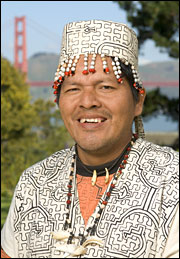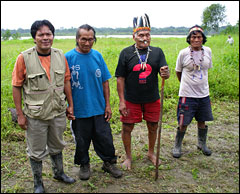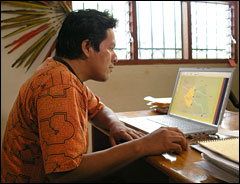
Julio Cusurichi Palacios.
Photo: Goldman Environmental Prize.
The Peruvian Amazon is one of the most remote places in the world. In its wildest corners, in the Madre de Dios region along the Brazilian border, some indigenous communities continue to live far from modern society. But their solitude is eroding: Loggers are pushing deeper into the forest, searching for increasingly rare stands of big-leaf mahogany, and oil development is on the rise.
Julio Cusurichi Palacios, an indigenous leader in the region, has allied himself with these “uncontacted” groups. For many years, he fought for the establishment of a forest reserve in the Madre de Dios — but when he succeeded, he found that his battle had just begun. He’s now training local people to guard the boundaries of the reserve, where they monitor and document the illegal logging that still occurs.
Cusurichi and his allies have also turned their attention to the United States, the main market for Peruvian mahogany. They’ve sued three U.S. timber importers and several government agencies, charging that the timber imports violate the Endangered Species Act and international law.
Cusurichi, 36, was awarded one of six 2007 Goldman Environmental Prizes at a ceremony in San Francisco on April 23. He spoke to Grist through a translator.
What are the most serious threats to the Peruvian Amazon?
The illegal logging and also the oil concessions, which overlap with the indigenous territories. The loggers come in, without any permission, and work in the territories of our indigenous brothers, who aren’t in contact with external society. This has caused confrontations and even deaths. When there are confrontations with these isolated indigenous groups, we never know how many of the indigenous peoples have been killed — we only hear about the loggers, because they’re the ones that come back.

With fellow indigenous leaders in the field.
Photo: Tom Dusenbery
These indigenous peoples are also very vulnerable to any type of disease, so when thousands of loggers come into their territory, they can bring diseases that these tribes have never seen before.
The loggers are going in and looking for mahogany, and they cut down lots of other trees to get to the mahogany. They make roads, and the animals in there flee. So these illegal loggers are hurting not just the indigenous peoples but the animals in the jungle as well. The oil activity in our area also doesn’t comply with the laws. Our government gives oil concessions right on top of our territories. The companies are contaminating the environment, contaminating our rivers with oil spills, and this causes serious [health] problems for our indigenous people. People come in and give them some medicines, but that’s not enough — the water is contaminated, the jungle is contaminated, there are no fish left, the helicopters fly overhead, and the oil pipelines pass through our land.
What was the community like where you grew up? Was it extremely isolated?
No, no, my community has been in contact with the outside world for a long time, because we were exploited by the rubber tappers. My grandparents were moved from the late 1800s and early 1900s. They were never able to return to the area where they came from, so my parents were born in this area, in the Amazonian province of Madre de Dios.
When and why did you decide to speak out on behalf of indigenous communities?
When I was very young, 10 or 11 years old, I began to understand how we were marginalized, how the way we were treated was not normal. Even as a youth I was working and organizing and making proposals with my people. Later I became a leader of my community, El Pilar, and then I became part of a regional organization, FENAMAD [Federation of Natives of the Madre de Dios River and its Tributaries]. There I got to know a different reality. I met different indigenous people in the area, and I realized that we were all confronting the same problems. Then I became really dedicated to this struggle to defend our rights. It became clear that we needed to find a way to get our problems resolved, to work with our government. But the truth is that they never seem to want to resolve our problems. They seem to want us to just disappear.
How has this reserve changed life for those who live within it?

Using today’s technology to protect ancient forests.
Photo: Tom Dusenbery
In the year 2002, after a long struggle, the reserve was created. In some ways we thought this was going to be a resolution, but the reserve was just created on paper. In reality thousands of loggers continued to go into the reserve. So we had to continue the struggle, to try and help the communities near the reserve, so they can make sure that none of the loggers are allowed into this territory. We’re constructing guard posts along all the entrances to the reserve, and working with the communities so that they can be vigilant.
Many of the leaders of these communities have been threatened. The loggers have written with graffiti on their homes, saying that they’re going to cut their necks, that they’re going to burn their villages to the ground. So there are threats, serious threats, to these communities.
What gives you and the people you work with the courage to continue?
These are our communities. We stand with our indigenous brothers and sisters, and we have to continue the struggle. We now know there are friends in other countries who can help us with our struggle — people who care about human rights, and protecting the jungle so that it can provide for us — and it helps us to have the solidarity of these other groups in other places.
What challenges remain?
We need to find a way to do sustainable activities in the forest. If we don’t actually do sustainable activities we’re going to have serious problems. The oil is going to run out, the trees will be gone, the gold will be gone. We could harvest Brazil nuts, we could have well-managed, sustainable logging, or we could have fish farming. We need an overall plan of management for the entire river basin, so that we can promote this kind of sustainable development and help future generations of our society.
What does this prize mean to you?
For me, it is a grand significance. I certainly didn’t expect it, but it’s great that there is some recognition of our work. It helps me understand and recognize that I’ve been doing the right thing. It means that I’m not going to be intimidated by economic interests or threats, and that I will be able to continue with my head held high until the last day of my life.

